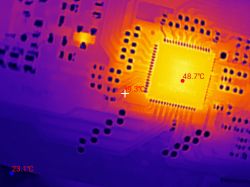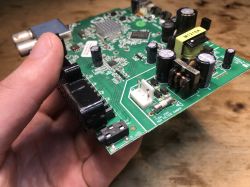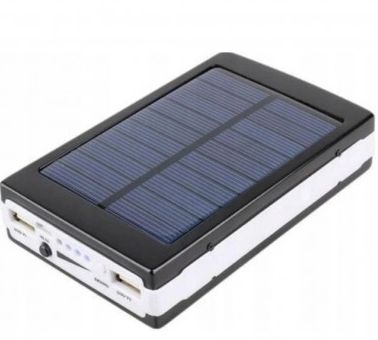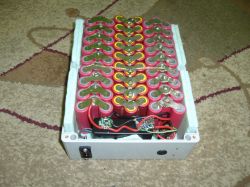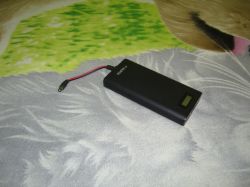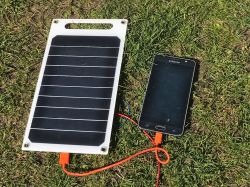
Hello my dear.
I invite you to a practical test of the cheapest solar charger with USB 5V output. This charger comes in the form of a single 26cm x 14cm panel and has an integrated converter with (if possible) a stable 5V output. In this topic, I will check whether in sunny, March / April weather, you can actually charge the phone with it and then show what the inverter looks like from the inside. The test will be made from the perspective of a typical user, i.e. I will take two phones (Samsung and Apple) and check whether they can be charged to any significant extent throughout the sunny day.
Purchase of a solar charger
Now I am not able to quote the specific price for which I bought this gadget, because it was about 1.5 years ago, but similar chargers are on the network under the slogan "USB 5V solar charger 6W", at the moment at prices around $ 10:

This 6W is rather a bit exaggerated, although retailers also sell this product as 20W and above.
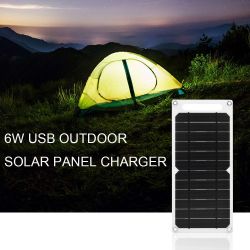
The dimensions of my charger (including margins) are 26cm by 14cm. There are several types of them on sale, all of them no-name, I am not able to recommend a specific seller who has "better" models.
First test
I chose the simplest possible test methodology - I just pick up the phone and try to charge it.
I made my first attempt on March 14th. A sunny day, one of the warmest. Around 15C.
I started charging at 13:30 with a 13% battery charge. I was charging via USB Doctor all the time, which significantly lowered the charging efficiency.

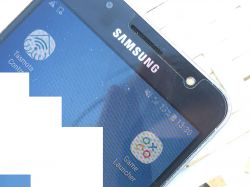
At 2:53 PM it was already 22%:
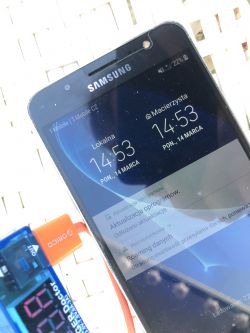
83 minutes of charging - an increase of approximately 9%.
Second test
I did the second test on March 23. Sunny day, almost 20C, it's practically spring.
This time I decided to charge directly from the panel, without an additional voltmeter / ammeter.
The day before the test, I unloaded the phone to zero, especially turning on the applications (something with 3D graphics) and the flashlight.
At 9:30 I made sure my phone was completely discharged to 0%.
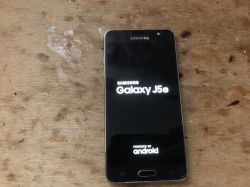
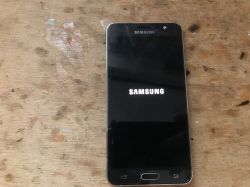
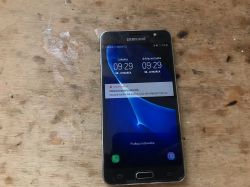
At 10:39 am I unfolded the panel and started charging (or so I thought).
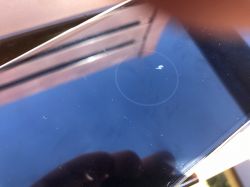
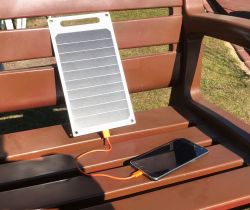
It turned out that I miscalculated - the phone did not charge at all, as I later checked the USB Doctor himself, it showed that no electricity was flowing.
At 12:52 I decided that it did not make sense - the phone is loaded to 0% and it is not able to start charging from this panel.
I made sure that the USB cable and the panel were really working - the LD25 showed almost 2.5W:
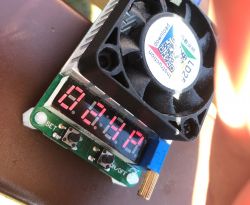
I decided to charge the phone a bit from my laptop. Just for the display to start working:
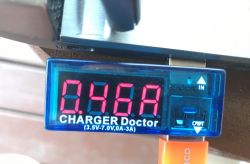
I charged it to 2%.
Around 1:12 pm I reconnected the phone and checked the power consumption.
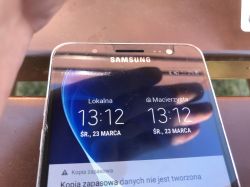
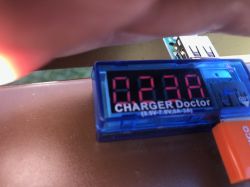
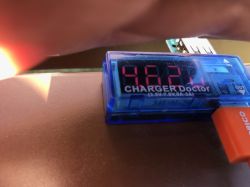
0.23A at 4.6V = 1W.
However, it should be remembered that USB Doctor can lower it, and for example the LD25 showed almost 2.5W.
At 1:18 PM it was already 3%.
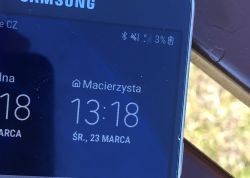
At 13:27 it was already 7%.
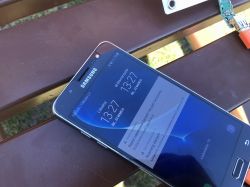
At 2:35 pm it was already 39%.
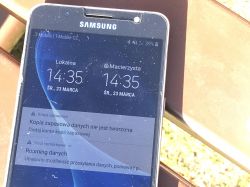
By 15:07 it was already 53%.
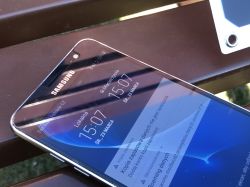
At 15:58 already 73%:
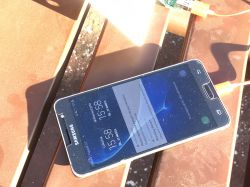
At 16:23 already 82%:

The phone was almost fully charged. Unfortunately, after 4:30 PM I had to finish, but I think that the experiment showed well that this charger works.
Conclusion: the phone completely discharged to 0 did not start charging, and when it was at least 1% it went smoothly.
Third test - iPhone 8
Now, for a change, a slightly different type of phone - iPhone 8, also unloaded to 0.
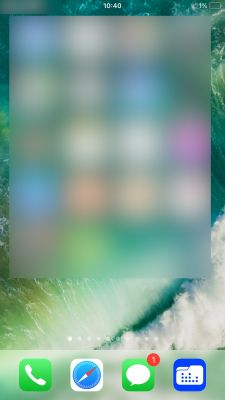
I started loading at 11:09 am:

This time I checked the currents on the USB Doctor right away - so that the phone is not charging because it is not turned on ... the results, however, were promising:
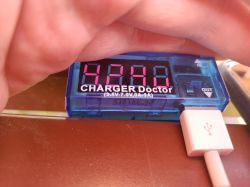
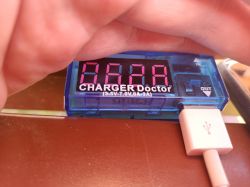
0.62A at 4.24V. This voltage is much lower than the minimum according to the USB standard (4.75V), but the phone is still charging. The panel gives less than 3W.
At 11:21 it was already 5% (anticipating the question - the charging icon disappeared because I covered the panel while standing to take a photo):
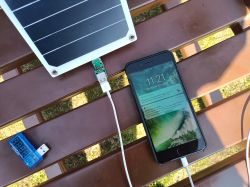
11:42 - 10%:
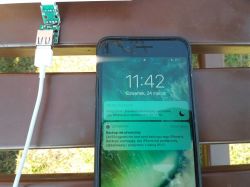
12:42 - 22%:
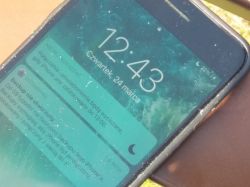
13:11 - 31%:
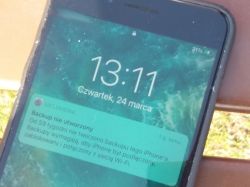
At this stage, I had to stop charging, but this charged iPhone worked all day this and the next, which shows well that this charger and him could extend his life.
Balcony test, fixing the panel on the balcony
So far, all tests have been performed by me outdoors, in fairly good weather and with the possibility of regular correction of the panel arrangement.
For a change, I decided to try slightly more difficult conditions.
I decided to install the panel on the balcony facing south. I designed the mounting in Blender and printed it on a 3D printer:
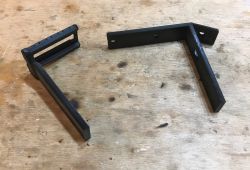

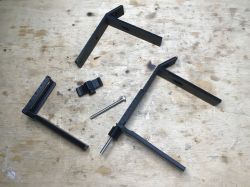
The fastening has a tightening mechanism implemented on the bolt and an additional knob that facilitates tightening:
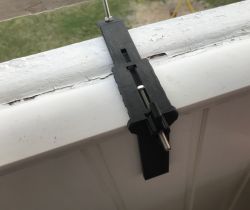
Additional (separately printed) elements holding the panel:
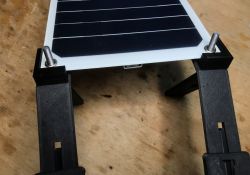
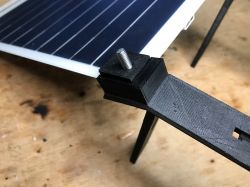
Ready mount, along with a red wire that only protects the panel so that if it is dropped, it does not fall down ...
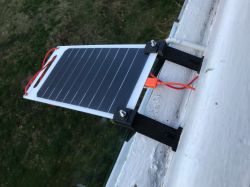
I started the test at 10:20 with 3%. The sun was regularly blocked by clouds.

At 4:30 PM I stopped because it started raining - 66% charged.
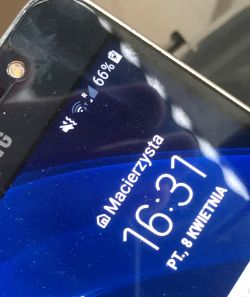
So you can also charge the phone from the balcony.
What's inside the charger?
I think experienced users can guess what can be found inside such a solar charger, but I decided to check it anyway. The white plastic mold is stuck with glue, but with the help of a knife I was able to remove it:
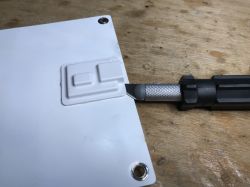
Integrated circuit, choke, rectifying diode (Schottki) ... a step down converter?
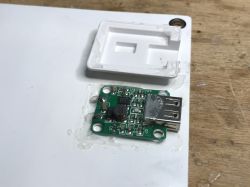
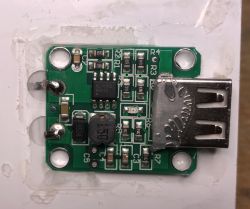
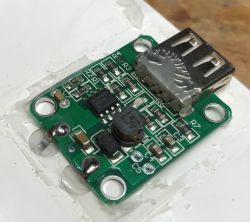
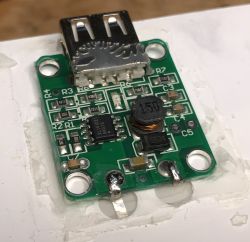
The IC is XL1410E1 and the diode is SS34.
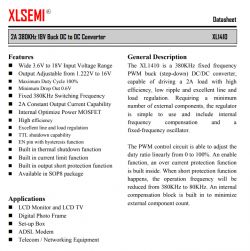
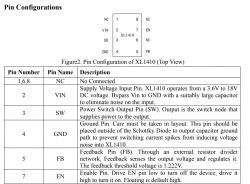
By the way, there is also a red LED on this module that lights up during operation. As you can see, the manufacturer assembled this charger from ready-made modules ...
Voltage before inverter, last tests
Due to bad weather, I had to wait a bit for a warm and sunny day, but when I finally did, I had the opportunity to measure the voltage in front of the step down converter.
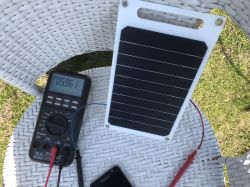
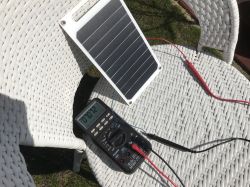
Illuminated - 7V
Shaded - 6V
Finally, I tried to measure with a second USB meter:
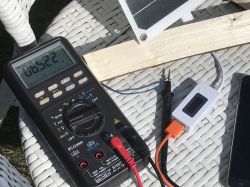
but I did not note any news, and the display of this meter is not visible in the pictures anyway.
What could be done better?
My play with the charger had one purpose - to check whether an ordinary "Kowalski" is able to charge the phone with it. And I think I answered that - absolutely yes. 3W can be pulled out of it.
The test could, however, be carried out much more scientifically. External power supply, microcontroller, RTCC, saving the current current and voltage to the SD card and then drawing a nice graph ...
The same should be remembered that "% charge" is a bad representation of how much the charger gives us, because the cells have different capacities and are in different states of wear (with time their capacity decreases)
I am fully aware of it, but I still think that I answered the question on the subject.
Summary
It turns out that this little solar charger is definitely able to charge a large part of the phone in one sunny day. , just remember that:
- any USB meters connected to the phone make charging difficult (the voltage drop below the USB standard itself may prevent charging at all)
- depending on the phone, there may be a problem with charging the phone completely discharged (my Samsung discharged to the point of complete shutdown did not want to charge at all, but as soon as I charged it from the laptop to 1%, it started to charge normally from the solar charger)
- of course, that the USB cable and its resistance matter
When it comes to measurements, this charger in the March / April Polish sun was able to give me up to 0.5A at 5V for Samsung and approx 0.7A at 4.9V for iPhone.
Another issue also arises - you have to remember that the phone itself decides what current it can take from the charger . The ways of determining the current efficiency of a charger vary between manufacturers. Some just jumper the D + and D- lines, and others connect them to VDD and ground through specific resistors. However, stillbetter chargers have an integrated circuit responsible for negotiation (and I do not mean the QC standard and higher voltages - these systems are also in chargers working only on 5V), for example IP2112 . Charger test based on IP2112 you can see here.
To sum up, I was able to get the most from this charger about 3W.
On the basis of this, you can already count and estimate how much we will actually charge during the day (roughly, because the angle of illumination itself is important).
I would like to add that both phones used for testing do not have batteries on the verge of exhaustion and after charging with a solar charger I could use them normally for a day, up to two days depending on the intensity level (for example, this iPhone lasts for a very long time, unless you take photos or actively browsing the internet).
That's it for me.
If there is interest, then I will perform a more detailed test later, with the creation of a current / voltage graph over time, of course with an external power supply so as not to interfere with the measurement results, but I think it will not be necessary.
In the meantime, I ask - how many of you are prepared for a longer lack of electricity supply? Such a charger may seem like a toy, but I think that if there was no electricity for 2 days, it would really save many people the possibility of using the phone (in good weather).
Cool? Ranking DIY Helpful post? Buy me a coffee.



